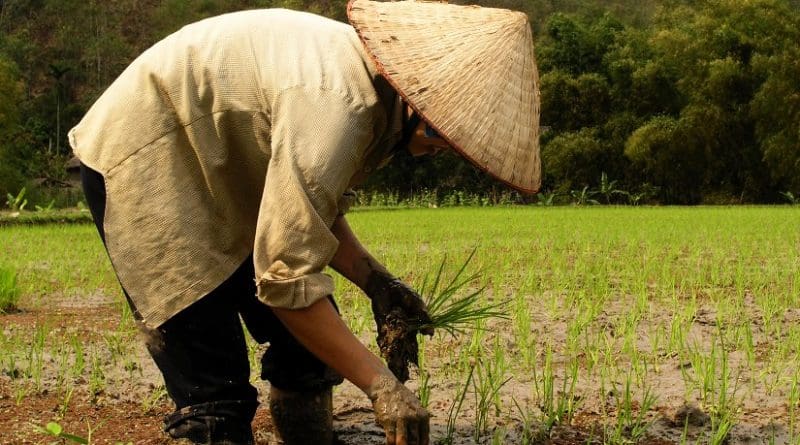Climate Change Threatens Agriculture In Pacific Rim Economies – Analysis
By IDN
By J Nastranis
Global warming is expected to have a significant impact on future yields of everything from rice to fish, particularly in countries situated closer to the equator, the Food and Agriculture Organization of the United Nations (FAO) has warned, and urged the Asia-Pacific economies to take a leading role in adaptation and mitigation.
“Many APEC [Asia-Pacific Economic Cooperation] economies have already felt the full force of agricultural losses from natural disasters in recent years, with the vast majority of these being climate related,” said Kundhavi Kadiresan, Assistant Director-General and FAO Regional Representative for Asia and the Pacific, reported UN News.
Geographically, the negative impact of climate change on agricultural output could result in lower yields of rice, wheat, corn and soybeans in countries with tropical climates, compared with the impacts experienced by those in higher latitudes. Fisheries could also be affected by changes to water temperature, the FAO cautioned.
“The annual tally runs into the billions and billions of dollars in losses. So, the time to act is now. Policy makers need to prepare for changes in supply, shifting trade patterns and a need for greater investment in agriculture, fisheries, land and water management, that will benefit smallholder farmers and others that produce our food,” Kadiresan added.
Many vital agricultural regions in Asia are at risk of crossing key climate thresholds that would cause plant and animal productivity to decline, according to a meeting in Viet Nam of Agriculture Ministers of APEC member economies.
Based on the findings of the global research community, the International Panel on Climate Change (IPCC) anticipates that these trends are expected to worsen in the future with the projected impacts of anthropogenic climate change.
Much can be done to increase the efficiency of agriculture and land-use activities in Asia, according to Kadiresan.
The agriculture sectors account for at least one-fifth of total emissions – mainly from forest to farmland conversions; livestock and paddy production; and application of synthetic fertilizers. Estimates show that 70 per cent of the technical potential to reduce agriculture emissions occurs in tropical developing countries, which characterize much of Asia.
“It is imperative that we start thinking now about the hard decisions and actions that the APEC economies, and others, will need to take. Governments will need to consider greater social protection measures. Industry and trade will need to adapt to shifting supply and demand. There is no quick fix but there is every reason to act,” stressed.
FAO has been working with the Ministry of Agriculture and Rural Development in Viet Nam to assess potential emission reductions the System of Rice Intensification and improved livestock management.
In Cambodia, Papua New Guinea and Mongolia, FAO, has partnered in developing programmes to measure, monitor and report emissions and adaptation actions in the agriculture and land-use sectors.
In the forestry sector, avoiding deforestation, increasing the area under forest, and adopting sustainable forest management will create invaluable carbon sinks. FAO has been supporting national programmes for reduced emissions from deforestation and forest degradation.
The meeting made clear that more upfront support is essential to increase farmers’ productivity, build capacity to adapt to climate change and reduce the emissions related to production.
A second area requiring financing is also needed to support capacity-building of appropriate institutions and policies. Climate funds could become an important catalyst for climate change adaptation and mitigation if they are used to build the enabling environment essential for climate-smart agricultural development, while ensuring that public agricultural investment is also climate-smart, and to leverage private finance.
Meanwhile, UN News reported that United Nations humanitarian agencies are working with the Government and partners in Nepal to bring in clean water, food, shelter and medical aid for some of the 41 million people affected by flooding and landslides in South Asia.
Nearly a thousand people have been killed, and tens of thousands of homes, schools and hospitals have been destroyed in Bangladesh, India and Nepal.
“There is the possibility that the situation could deteriorate further as rains continue in some flood-affected areas and flood waters move south,” the UN Office for the Coordination of Humanitarian Affairs (OCHA) on August 24 said in an updated note.
In Bangladesh, nearly 2,000 local medical teams have been deployed, even as one-third of the country is reportedly underwater. Aid workers are concerned about waterborne diseases, such as diarrhoea and malaria.
“Their most urgent concern is to accessing safe water and sanitation facilities,” OCHA said earlier, citing national authorities. It also warned of dangers to women and children, who are at increased risk for abuse, violence and sexual harassment. In India, rescue operations are ongoing in many flood-affected areas, with those stranded being rescued by helicopter.
Flood relief camps have been established for those displaced by the disaster where they are being provided with food and shelter, OCHA said. The Government recently announced additional funding for relief, rehabilitation, reconstruction and flood mitigation. In addition to people suffering, Indian authorities also reported large parts of a famous wildlife reserve park destroyed, with endangered animals killed.

